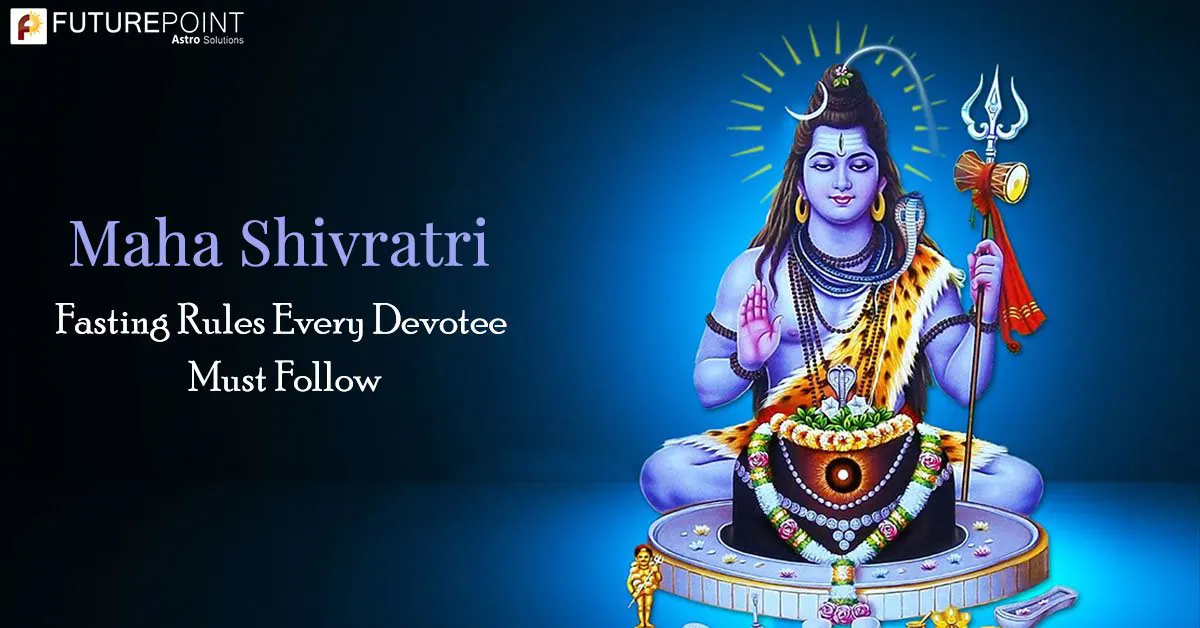Maha Shivratri Fasting Rules - What devotees should know?
By: Future Point | 12-Feb-2018
Views : 5410
Maha Shivratri is one of the most auspicious and sacred festivals of Hindus; especially for the ones who are devotees of the Supreme Lord Shiva. It is said and believed that fasting and observing vigil on this auspicious day can win the blessings of Lord Shiva in abundance. Shivratri or Maha Shivratri- ‘the great night of Lord Shiva’, always fall on the Chaturdashi(14th day) of Krishna Paksha (dark phase of the month).
In the year 2020, Maha Shivratri will be celebrated on 21st February 2020, Friday.
There is a great Hindu ritual of fasting on the night of Shivratri. People generally celebrate this festival by singing hymns and praises in the name of Lord Shiva. It is during this day, all Hindu temples are decorated with lights and colorful decorations and night-long prayers are being offered to the Shiva Lingam. There’s great importance levied on Maha Shivaratri and the fast observed on that day. Learn what the devotees must keep in mind at the time of fasting and also about the Puja Timings and ways to celebrate this festival.
Significance of Maha Shivratri:
There is a mention of Maha Shivratri in our Hindu Puranas, especially in the Skanda Purana, Linga Purana, and Padma Purana. According to one of the most prevalent mythological legends in the Shivaism Tradition, Shiva Ratri is considered to be the night when Lord Shiva performs the heavenly and magical dance of creation, preservation, and destruction of life. While, according to some other myths, it is the night of holy matrimony of Lord Shiva and Goddess Parvati.
Maha Shivratri Puja Timings:
Usually, there are always four rounds of puja that happens throughout the night of Shivratri. It is during this night, people observe fast and visit and elaborated long pujas are performed in Hindu temples to gain the divine blessings of Lord Shiva. The Maha Shivratri puja timings for this year are as follows:
Chaturdashi Tithi Begins: 5:20 PM on 21st February 2020
Chaturdashi Tithi Ends: 07:02 PM on 22nd February 2020
Nishita Kaal Puja Time = 12:27 AM to 01:17 AM (22nd February 2020)
First Prahar Puja Time (Night): 6:41 PM to 9:46 PM (21st February)
Second Prahar Puja Time (Night): 9:46 PM to 12:52 AM (22nd February)
Third Prahar Puja Time (Night): 12:52 AM to 03:58 AM (22nd February)
Ratri Fourth Prahar Puja Time: 3:58 AM to 7:03 AM (22nd February)
Time To Break Your Fast: 7:03 AM to 3:47 PM (on 22nd February)
Simple Fasting Rules for the Auspicious Day of Maha Shivratri
This festival of Shivratri is celebrated by observing fast on the morning of Shivratri, which ends on the following morning of the next day. Fasting rules for all the Shivratri (one falls each month) are common for all including the Maha Shivratri. People observe fast as per their own beliefs and rituals. While some of the people observe fast without water (Nirjala Vrat), it is not recommended considering the effects on health. One may observe a fast by eating few fruits and water, or with small quantities of light food to keep the body hydrated.
What can be eaten at the time of Fast?
If you are not fasting on a Nirahaar Fast that is restrained from eating any form of food, you can eat the following dishes. But, make sure that if you are fasting on the auspicious day of Shivratri, your food must not contain rice, pulses, wheat and table salt, and you can always use rock salt as an alternative to this. Listed below are some of the example foods which you can have during your fast:
- Barnyard Millet or Sama Ka Chawal.
- Tapioca Khichdi or Sabudana Khichdi.
- Buckwheat unleavened deep-fried bread or kuttu puri.
- Halwa made from chestnut flour or Singhara Halwa.
- Pumpkin soup.
Also, please note that all the above food should be consumed by sprinkling only rock salt.
It is also believed that when the mind and body both are detoxified, the strength and power of one’s prayers also increase. Therefore, observing fast on Maha Shivratri can increase the possibility of getting desires manifested and fulfillment of wishes.
Parana Time: It is the correct time when one can break the fast. This year on Maha Shivratri, the Parana time is between 06:35 am to 15:16 pm on 14 February 2018, Wednesday.
Significance of Sacred Bath of Shiva lingam:
It is during Shivratri or Maha Shivratri, a sacred bath is performed on the Shiva lingam in homes or temples with full zeal and fervor.
Important Timings for Abhishek or Puja:
This Abhishek or Puja can be performed in four rounds but if there is only one puja to be performed on Maha Shivratri, then it should be done between 23:58 to 24:47+ on the night of 13th February 2018, Tuesday. The most auspicious time of Shivratri Puja is also called as Nishita Kaal. The puja duration of 49 minutes will be beneficial during this year’s Maha Shivratri. The puja is performed when devotees bathe the sacred linga with milk, honey, curd, ghee, and sandalwood leaves by constantly chanting the holistic mantra of “Om Namaha Shivaaye”. Fruits like bel Patra (bael leaves), ber (jujube) and flowers are also offered to the Shiva Linga.
To obtain prosperity & abundance in your life, observe a fast on the day of Maha Shivratri in 2020. With Lord Shiva’s grace in life, you can attain all the bounties of nature in your life. Perform Rudrabhishek Puja on Maha Shivratri.